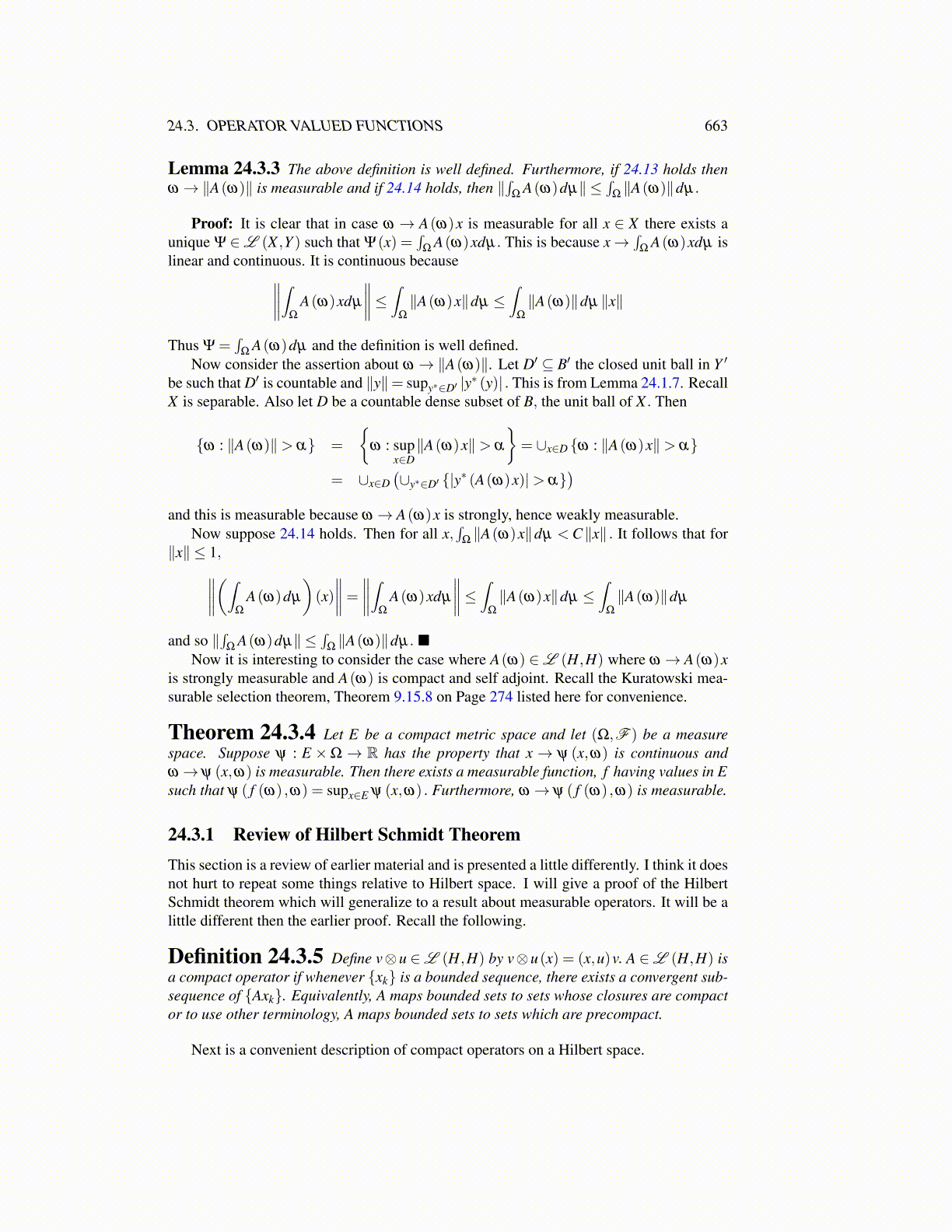
24.3. OPERATOR VALUED FUNCTIONS 663
Lemma 24.3.3 The above definition is well defined. Furthermore, if 24.13 holds thenω →∥A(ω)∥ is measurable and if 24.14 holds, then ∥
∫Ω
A(ω)dµ∥ ≤∫
Ω∥A(ω)∥dµ.
Proof: It is clear that in case ω → A(ω)x is measurable for all x ∈ X there exists aunique Ψ ∈L (X ,Y ) such that Ψ(x) =
∫Ω
A(ω)xdµ. This is because x→∫
ΩA(ω)xdµ is
linear and continuous. It is continuous because∥∥∥∥∫Ω
A(ω)xdµ
∥∥∥∥≤ ∫Ω
∥A(ω)x∥dµ ≤∫
Ω
∥A(ω)∥dµ ∥x∥
Thus Ψ =∫
ΩA(ω)dµ and the definition is well defined.
Now consider the assertion about ω → ∥A(ω)∥. Let D′ ⊆ B′ the closed unit ball in Y ′
be such that D′ is countable and ∥y∥= supy∗∈D′ |y∗ (y)| . This is from Lemma 24.1.7. RecallX is separable. Also let D be a countable dense subset of B, the unit ball of X . Then
{ω : ∥A(ω)∥> α} =
{ω : sup
x∈D∥A(ω)x∥> α
}= ∪x∈D {ω : ∥A(ω)x∥> α}
= ∪x∈D(∪y∗∈D′ {|y∗ (A(ω)x)|> α}
)and this is measurable because ω → A(ω)x is strongly, hence weakly measurable.
Now suppose 24.14 holds. Then for all x,∫
Ω∥A(ω)x∥dµ < C∥x∥ . It follows that for
∥x∥ ≤ 1,∥∥∥∥(∫Ω
A(ω)dµ
)(x)∥∥∥∥= ∥∥∥∥∫
Ω
A(ω)xdµ
∥∥∥∥≤ ∫Ω
∥A(ω)x∥dµ ≤∫
Ω
∥A(ω)∥dµ
and so ∥∫
ΩA(ω)dµ∥ ≤
∫Ω∥A(ω)∥dµ. ■
Now it is interesting to consider the case where A(ω) ∈L (H,H) where ω → A(ω)xis strongly measurable and A(ω) is compact and self adjoint. Recall the Kuratowski mea-surable selection theorem, Theorem 9.15.8 on Page 274 listed here for convenience.
Theorem 24.3.4 Let E be a compact metric space and let (Ω,F ) be a measurespace. Suppose ψ : E ×Ω → R has the property that x → ψ (x,ω) is continuous andω→ψ (x,ω) is measurable. Then there exists a measurable function, f having values in Esuch that ψ ( f (ω) ,ω) = supx∈E ψ (x,ω) . Furthermore, ω → ψ ( f (ω) ,ω) is measurable.
24.3.1 Review of Hilbert Schmidt TheoremThis section is a review of earlier material and is presented a little differently. I think it doesnot hurt to repeat some things relative to Hilbert space. I will give a proof of the HilbertSchmidt theorem which will generalize to a result about measurable operators. It will be alittle different then the earlier proof. Recall the following.
Definition 24.3.5 Define v⊗u ∈L (H,H) by v⊗u(x) = (x,u)v. A ∈L (H,H) isa compact operator if whenever {xk} is a bounded sequence, there exists a convergent sub-sequence of {Axk}. Equivalently, A maps bounded sets to sets whose closures are compactor to use other terminology, A maps bounded sets to sets which are precompact.
Next is a convenient description of compact operators on a Hilbert space.